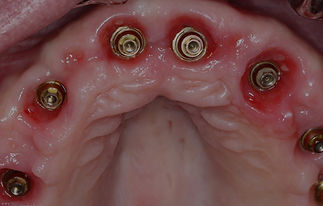
Symptoms
Early Signs (Peri-Implant Mucositis – reversible)
Dental implant infections are more common than people realize
-
Redness or inflammation around the implant site
-
Swelling of the gums
-
Bleeding when brushing
-
Mild discomfort or tenderness
-
Slight bad breath or bad taste in the mouth
Gingivitis in Teeth = Mucositis in Implants
Dental implant infections are more common than most people realize and are often preventable. Find out what causes them, how to spot the symptoms, and what you can do today to protect your health and your investment.
Implant mucositis is a reversible inflammatory condition affecting the soft tissues surrounding a dental implant, without any accompanying loss of the supporting bone.
Key Features:
-
Cause: Primarily due to bacterial plaque accumulation, similar to gingivitis around natural teeth.
-
Symptoms:
-
Redness and swelling of the peri-implant mucosa
-
Bleeding on probing (BOP)
-
Possible tenderness or mild discomfort
-
No radiographic bone loss (compared to baseline after implant placement)
-
Important Distinction:
-
Implant mucositis affects only the soft tissue.
-
Peri-implantitis, in contrast, involves both inflammation and progressive bone loss around the implant.
Treatment:
-
Improved oral hygiene
-
Professional debridement, air polishing, laser, and irrigation
-
Antimicrobial therapy (e.g., ozone water, molecular iodine)
-
Patient education and maintenance program
Prognosis:
-
Good if caught early and managed appropriately—progression to peri-implantitis can be prevented.
Periodontitis in Teeth = Peri Implantitis in Implants
Peri-implantitis is a destructive inflammatory disease affecting the soft and hard tissues surrounding a dental implant, leading to progressive bone loss and potential implant failure if left untreated.
Key Features:
-
Etiology: Typically caused by bacterial plaque and exacerbated by risk factors such as:
-
Poor oral hygiene
-
History of periodontitis
-
Smoking
-
Diabetes
-
Excess cement or ill-fitting restorations
-
-
Clinical Signs:
-
Redness, swelling, and suppuration of the peri-implant mucosa
-
Bleeding on probing (BOP)
-
Increased probing depths
-
Radiographic evidence of bone loss
-
Sometimes pain or implant mobility (in advanced cases)
-
-
Diagnosis:
-
Comparison to baseline radiographs to assess bone loss
-
Clinical inflammation plus ≥2 mm of bone loss (after initial remodeling)
-
Implant Mucositis vs Peri-Implantitis
Feature Implant Mucositis Peri-implantitis
Affects Soft tissue only Soft tissue and bone
Bone Loss None Yes and progressive
Bleeding Yes Yes
Reversibility Yes Not fully reversible
Treatment Focus Control infection Control infection and bone loss
Treatment Approaches:
-
Non-surgical:
-
Ultrasonic debridement
-
Air Polishing
-
Laser
-
Antimicrobial therapy (e.g., Ozone water, Molecular Iodine )
-
-
Surgical:
-
Laser surgery for decontamination
-
Regenerative procedures (e.g., bone grafts, membranes)
-
-
Supportive Therapy:
-
Ongoing maintenance
-
Patient education and risk management
-